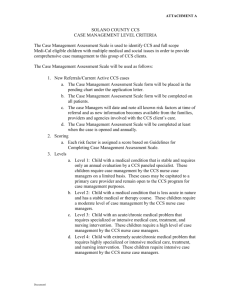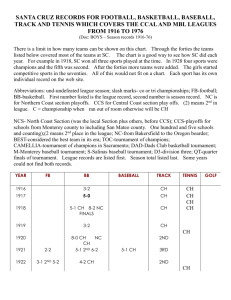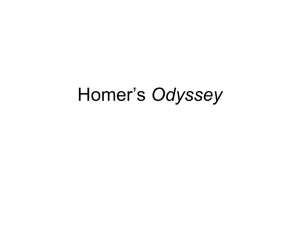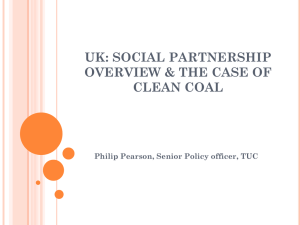CCS_Workshop_Agenda_082112
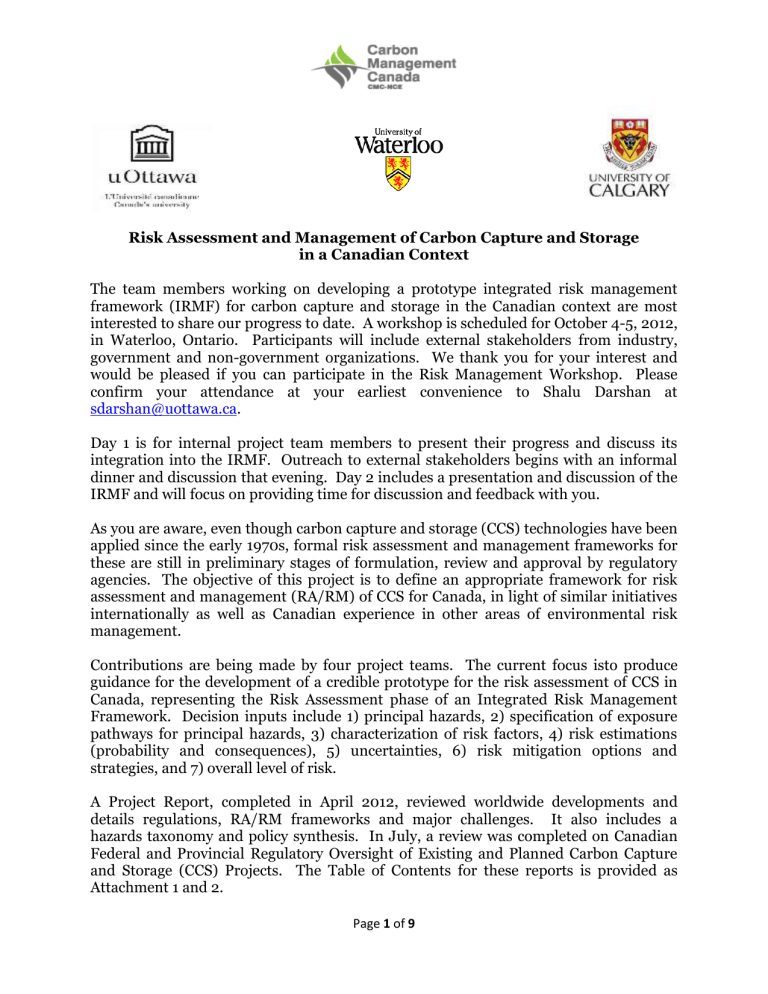
Risk Assessment and Management of Carbon Capture and Storage in a Canadian Context
The team members working on developing a prototype integrated risk management framework (IRMF) for carbon capture and storage in the Canadian context are most interested to share our progress to date. A workshop is scheduled for October 4-5, 2012, in Waterloo, Ontario. Participants will include external stakeholders from industry, government and non-government organizations. We thank you for your interest and would be pleased if you can participate in the Risk Management Workshop. Please confirm your attendance at your earliest convenience to Shalu Darshan at sdarshan@uottawa.ca
.
Day 1 is for internal project team members to present their progress and discuss its integration into the IRMF. Outreach to external stakeholders begins with an informal dinner and discussion that evening. Day 2 includes a presentation and discussion of the
IRMF and will focus on providing time for discussion and feedback with you.
As you are aware, even though carbon capture and storage (CCS) technologies have been applied since the early 1970s, formal risk assessment and management frameworks for these are still in preliminary stages of formulation, review and approval by regulatory agencies. The objective of this project is to define an appropriate framework for risk assessment and management (RA/RM) of CCS for Canada, in light of similar initiatives internationally as well as Canadian experience in other areas of environmental risk management.
Contributions are being made by four project teams. The current focus isto produce guidance for the development of a credible prototype for the risk assessment of CCS in
Canada, representing the Risk Assessment phase of an Integrated Risk Management
Framework. Decision inputs include 1) principal hazards, 2) specification of exposure pathways for principal hazards, 3) characterization of risk factors, 4) risk estimations
(probability and consequences), 5) uncertainties, 6) risk mitigation options and strategies, and 7) overall level of risk.
A Project Report, completed in April 2012, reviewed worldwide developments and details regulations, RA/RM frameworks and major challenges. It also includes a hazards taxonomy and policy synthesis. In July, a review was completed on Canadian
Federal and Provincial Regulatory Oversight of Existing and Planned Carbon Capture and Storage (CCS) Projects. The Table of Contents for these reports is provided as
Attachment 1 and 2.
Page 1 of 9
Attachment 1
CMC-NCE Project on Risk Assessment for CCS (Year 1)
McLaughlin Centre, University of Ottawa
Final Project Paper (April 2012)
Table of Contents
Chapter 1: Introduction and Overview (3pp.).
Chapter 1 provides an overview of the rationale for the current work and an overview of the contents of the various chapters.
Chapter 2: CCS Projects Worldwide (6pp.).
Chapter 2 consists of tables listing the CCS projects that are under way or in planning around the world, including (a) pilot or demonstration projects, (b) full-scale energy-generating projects, and (c) enhanced oil recovery projects.
Chapter 3: CCS Regulations Worldwide (19pp.).
Chapter 3 consists of two parts:
(a) a narrative summary of domestic and international regulations, guidance and standards relating to the management of risks associated with Carbon Capture and Storage, including full references;
(b) a comparative table on the mandatory vs. voluntary components of Risk Assessment and Risk Management featured in regulatory frameworks.
Chapter 4: CCS RA/RM Frameworks Worldwide (48pp.).
Chapter 4 consists of five parts:
(a) synopsis of narrative summary;
(b) a narrative summary of RA/RM perspectives for CCS from both government and non-government sources;
(c) a comparative table showing the detailed components of RA and RM as they are featured in regulatory frameworks;
(d) a compilation of abstracts of journal articles in this area;
(e) a chronology of major developments in RA and RM for CCS, with URLs.
Page 2 of 9
Chapter 5: Hazards Taxonomy for CCS (15pp.).
Chapter 5 consists of a paper by Professor Maurice Dusseault, University of Waterloo, entitled “Carbon Dioxide Sequestration Risks,” which was prepared specifically for this project.
Chapter 6: Applying the Hazards Taxonomy to a Risk Assessment for CCS (2pp.).
Chapter 6 analyzes the requirements for future work needed to proceed from the hazards taxonomy (Chapter 5) to the formal elements of the Risk
Assessment Phase of an Integrated Risk Management Framework for CCS in Canada.
In this context special attention should be paid to Appendix 2, “Risk
Assessment Tools” (Table 5), at pages 48ff., in: U. S., Department of
Energy, National Energy Technology Laboratory, Risk Analysis and
Simulation for Geologic Storage of CO
2
, March 2011: http://www.netl.doe.gov/technologies/carbon_seq/refshelf/BPM_RiskAnal ysisSimulation.pdf
.
Chapter 7: Major Challenges in CCS (27pp.).
Chapter 7 provides an overview of the unique challenges to a credible RA and RM for CCS, including both “technical” and “social” dimensions of risk, on the basis of current knowledge.
Chapter 8: Policy Synthesis – The Path forward for Canada on CCS (4pp.).
Chapter 8 provides some initial thoughts on utilizing the risk assessment for CCS in the Canadian context.
Chapter 9: Appendix A (IRMF – CCS) (3pp.).
The draft form of the flow-chart diagram for RA and RM of CCS are given here.
Chapter 10: Appendix B (CCS project database) (48pp.).
The individual data sheets on the worldwide CCS projects (Chapter 2) are provided here.
Page 3 of 9
Total approximately 170 pages (single-spaced).
Attached PDF filenames:
CFIA BSE Risk Assessment
FutureGen Risk Assessment
FutureGen Risk Assessment Methodology
NETL CCS Risk Analysis Simulation
Page 4 of 9
Attachment 2
Canadian Federal and Provincial Regulatory Oversight of Existing and Planned Carbon Capture and Storage (CCS) Projects
Table of Contents
Part 1: Synopsis (4 pp.)
Part 2: Federal and Provincial Regulatory Oversight (9 pp.)
This Part provides an overview of primary federal and provincial regulatory oversight that may have applied to CCS projects to date.
Part 3: Project Descriptions and Regulatory Outcomes (43pp.)
In this Part, each entry includes a brief project description, discussion of regulatory outcomes under the primary applicable legislation described in Part 2
(with subcategories describing the Application, Expert Review (where applied) and Approval), and notes on communication and consultation activities. Part 3D provides a comparative table of various project considerations.
Part 3A: Larger Projects
Weyburn-Midale Enhanced Oil Recovery (EOR) Operations – Cenovus and
Apache Canada Ltd
Boundary Dam Carbon Capture Project – SaskPower with other operators
Alberta Carbon Trunk Line Project – Enhance Energy with other operators
Part 3B: Smaller or Research Projects
IEA GHG Weyburn CO2 Monitoring and Storage Project – IEAGHG Partnership, managed by Petroleum Technology Research Centre
Aquistore Project – Petroleum Technology Research Centre with SaskPower
Swan Hills Unit #1 CO2 Injection Pilot Project – Devon Canada Corporation
Zama Acid Gas Enhanced Oil Recovery Project – Apache Canada Ltd
Part 3C: Projects at earlier phase of development
North West Upgrader – North West Redwater Partnership
In-situ Coal Gasification with CCS - Swan Hills Synfuels with other operators
Shand Power Capture Project – SaskPower and others
Fort Nelson Demonstration Unit – Spectra Energy
Page 5 of 9
References (5pp.)
Appendices (18pp.)
Total approximately 82 pages (single-spaced).
Page 6 of 9
7:00 pm
Carbon Capture and Storage (CCS)
Risk Management Workshop
October 3-5, 2012
CIGI - Centre for International Governance
57 Erb St West
Waterloo
7:45 am – 8:30 am
8:30 am – 9:45 am
9:45 am to 11:00 am
October 3 rd
,
2012
Evening Meet & Greet
Team Leaders and Students
October 4 th
,
2012
Team Progress
Light Breakfast
Ottawa – McLaughlin Centre for Population Health Risk
Assessment Project Presentation and Discussion
Bill Leiss: Overview of Integrated Risk Management Framework for
CCS in the Canadian Context
Waterloo - Project Presentations and Discussion
Araz Mirhamed : Connecting Carbon Sequestration Monitoring and
Risk Analysis - A Bayesian Framework
Chris Ladubec : Efficient Simulations of Carbon Dioxide Leakage from Abandoned Wells for Risk Analysis
Page 7 of 9
11:00 am – 11:15 am
Farshad Arfiei Malekzadeh : Injection Strategies to Maximize
Carbon Dioxide Dissolution in Deep Aquifers
James Petrosky : A Review of GeoRisk Issues in CO
2
Disposal
11:15 am to 12:15 pm
12:15 pm to 12:30 pm
Coffee Break
Ottawa – Department of Engineering Project Presentation and
Discussion
Mamadou Fall, Zhenze Li: Risk Assessment of CCS: Lessons learned from experience in nuclear power and groundwater contamination by CO
2
Waterloo
– Commentary on Related Energy Resource Issues
Maurice Dusseault : Shale Gas Development in North America
12:30 pm to 1:30 pm
1:30 pm to 2:45 pm
Lunch & Discussion
Calgary - Project Presentation and Discussion
Joe Arvai: A Decision Support Framework for Energy Transitions
2:45 pm to 3:15 pm
3:15 pm to 5:00 pm
Coffee Break
Next Steps on Integrated Risk Management Framework
Preparation for Discussion with Stakeholders
Meeting Milestones
7:00 pm
Dinner with Stakeholders
Bill Leiss : Brief Introduction to the Project
Page 8 of 9
October 5 th
,
2012
Discussion with External Stakeholders
7:45 am to 8:30 am Light Breakfast
8:30 am to10:00 am
10:00 am to 10:30 am
10:30 am to 12:30 pm
12:30 pm to 2:00 pm
Introductions
Ottawa
– McLaughlin Centre for Population Health Risk
Assessment
Bill Leiss: Progress on Integrated Risk Management Framework
Break & Discussion
Stakeholder Presentations and Discussion
Lunch
2:00 pm to 4:00 pm
Stakeholder Feedback and Further Discussion
4:00 pm Adjourn
Page 9 of 9

